Are you thinking of buying a black diamond ring? If so, you’re probably wondering what makes them so special. In this guide, we will discuss everything you need to know about black diamonds. We will talk about their history, how they are mined and processed, and the different types of black diamonds that are available. By the end of this guide, you’ll understand everything there is to know about these unique gems!
What is a black diamond?
Diamonds with a high number of inclusions are known as “black diamonds.” On a typical white or colorless diamond, inclusions may look like tiny dark flecks, but at very high levels, the diamond appears to be entirely black. As a result, you get a black diamond.
This makes it a one-of-a-kind and remarkably unique type of colored diamond. In comparison to other fancy-colored diamonds, black diamonds are not typically formed by chemical impurities that were present during the diamond’s composition.
Usually, the vast mineral inclusions in black diamonds, which are visible on their monochromatic surface, are what give them their color. For instance, black diamonds, however, resemble white diamonds more than they do yellow or blue diamonds.
Due to its alluring and vividly black color, the Black Diamond is known by numerous names. A natural-hue black diamond is also known as a “Carbonado,” a Portuguese term for an opaque black diamond. For gemologists, carbonado is the polycrystalline, amorphous form of the uncooked mineral that is rich in graphite and diamonds.
Black diamonds lack the sparkle and brilliance that we frequently associate with diamonds because they are naturally opaque. However, the “adamantine” luster is noticeable, which enhances the elegance of this priceless stone.
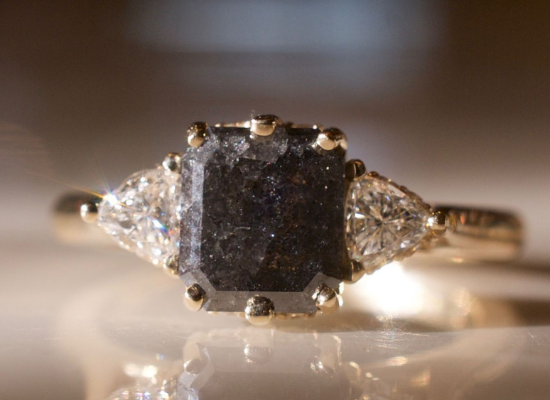
The interesting origin of carbonado
Carbonado is only found in Brazil and the Central African Republic due to its antiquity. At that time in Earth’s history, modern-day Brazil and the western coast of Africa may have formed a “supercontinent.” However, a diamond meteorite that reached Earth during that time may help to explain Carbonado’s current distribution.
Carbonado diamonds may have formed as a result of supernova explosions that launched fragments of the material into space, eventually colliding with the Earth’s surface. Carbonado may have been created 2.6 to 3.8 billion years ago by the collision of asteroid-sized diamond bodies with the Earth’s unusual geology and oxygen-poor atmosphere. So, by picking a black diamond, you can claim to be wearing a meteorite or a piece of a supernova.
How are black diamonds processed?
Black diamonds are colored using a range of processes before being utilized in jewelry. High-pressure/high-temperature (HPHT) and radiation are two options. Regardless of whether it has been colored or not, a diamond is recognized by its chemical composition (carbon with minor impurities) and crystalline atomic structure.
The term “raw black diamond” refers to carbonado, a polycrystalline or aggregate substance made up of amorphous graphite, carbon, and diamond. This aggregate has several industrial uses since it is more durable than a diamond.
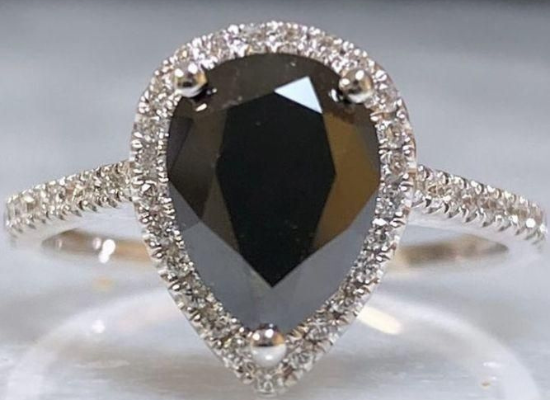
Types of black diamonds
Black diamonds come in two main types: natural black diamonds and diamonds that have been treated to become black. Diamonds that have a natural black appearance are significantly more valuable and desirable.
The second type are white diamonds with a high number of inclusions and fractures and often a dull grey appearance. In their initial state, these diamonds are nearly worthless and are only used for industrial purposes. Heat, pressure, and irradiation treatments can be used to create a black hue, resulting in a black diamond.
Natural black diamonds, in contrast, develop their color naturally throughout the creation process without the involvement of outside factors. These also contain numerous inclusions, and these inclusions form clusters of graphite, giving the stone a black, metallic appearance.
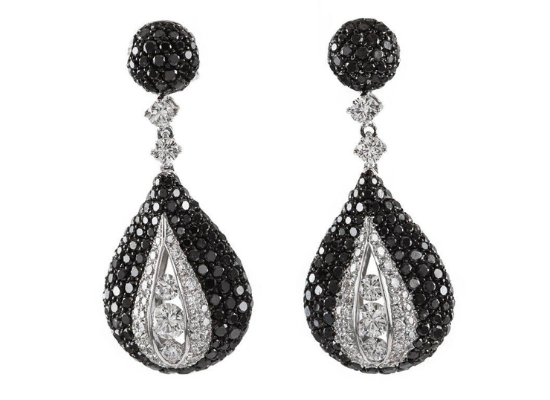
What does a black diamond symbolize?
The black diamond represents unchanging love/eternal love and is associated with eternity, perfection, mystery, power, strength, and authority. And because of that, they are ideal for black diamond jewelry.
It’s interesting to note that black diamonds have long been thought of as mystical gems that might ward off evil spirits and purify the wearer of bad luck. These black jewels were also used in the past by several cultures as a form of communication between the human and divine worlds.
In addition, black diamonds are thought to symbolize charm and have the power to help you shape your future. Black diamonds are consequently linked to a strong sense of self-worth and desire.
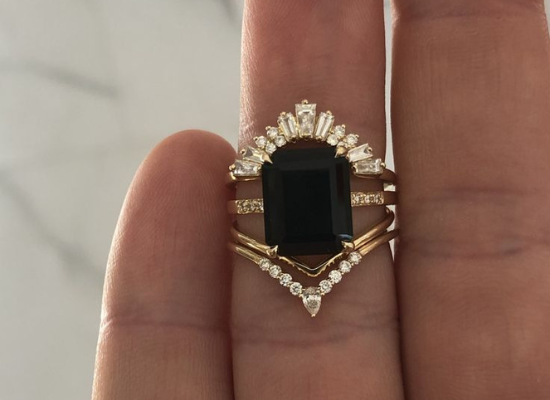
Are black diamonds expensive?
There are very affordable variations of the black diamond and some that are more on the expensive side. Supply and demand play a major role in pricing. Black diamonds come in both natural and treated varieties, and each has its benefits and disadvantages.
Most black diamonds on the market are heat treated and are more affordable than diamonds that are naturally black. As little as $100 to $200 per carat is all you need to pay for an enhanced black diamond. Keep in mind, though, that sometimes heat treating a stone can weaken it. Heat treated black diamonds could be weaker than natural black diamonds.
Lab-created black diamonds are also less expensive than mined ones. They are just as durable as natural diamonds because they are grown with the color already in them. Regardless of origin, a black diamond’s value is based on the same criteria as all diamonds—the 4C’s: clarity, cut, color, and carat. Unlike colorless diamonds, clarity is based on the external conditions of the stone. However, the higher the carat weight, the bigger the price tag.
Both carbonados and fancy black diamonds are incredibly rare. Black diamonds make up only a small percentage of the 10,000 natural diamonds that are colored. Natural black diamonds and carbonados are among the most expensive and valuable gems due to their rarity.
Natural black diamonds that the GIA has verified may sell for between $1,000 and $3,000 per carat. Depending on the quality of the diamond, it may be considerably more expensive than a white diamond of similar size.
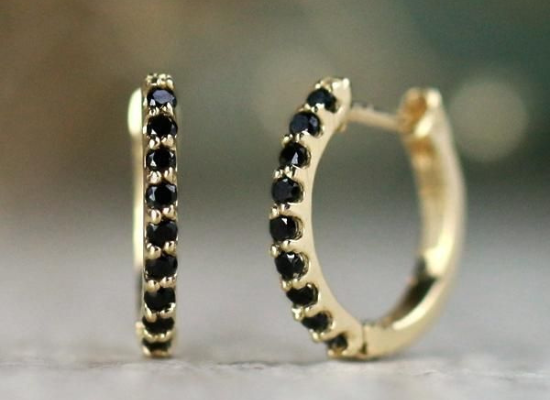
Black diamond’s levels of intensity
Black diamonds are only found in one color intensity: fancy black, unlike most other colored diamonds, which come in a variety of colors.
If you’re buying a black diamond engagement ring, a loose black diamond, or other jewelry, you should take the 4Cs (cut, clarity, color, and carat) into consideration just like you would with other diamonds. The value and quality of a black diamond are greatly influenced by all these variables.
Despite the fact that fancy black diamonds are not given the standard color and clarity grading, it is crucial to ensure that the color is completely saturated. When checking the stone with your naked eye, be sure there are no noticeable flaws.
You should also think about the shape when choosing a black diamond, which is definitely a matter of taste. Black diamonds, like other diamonds, come in a variety of shapes, each of which has a unique appearance.
Picking the right metal for black diamond jewelry is another key factor. Due to their stunning, powerful color, black diamonds look wonderful when set in 14k white gold or other white metals.
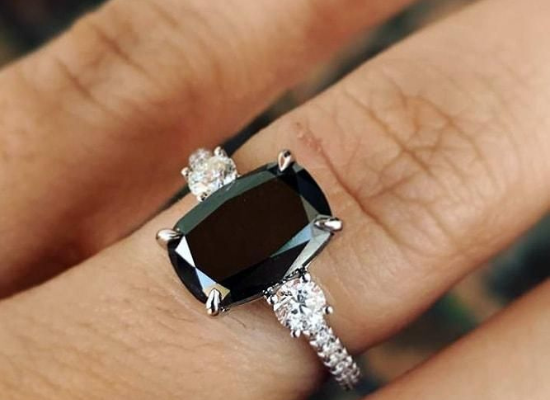
Thinking about a black diamond engagement ring?
Any black diamond engagement ring is sure to draw a lot of attention because black diamonds are so unique.
Your search might come up empty if you’re looking for a black diamond engagement ring. Due to the rarity of these stones, finding a high-quality diamond could be challenging. Since clarity is rarely confirmed, the cut and carat are important here. Because black diamonds don’t reflect light, you should choose an engagement ring with a sparkle-guaranteed design.
For an engagement ring that will be treasured for years to come, pair your stone with a stunning, suitable setting.
Black diamond engagement ring settings.
- Halo setting: Create a striking ring look by surrounding your black diamond with small colorless diamonds.
- Side stone setting: A white diamond on either side of your black diamond will draw attention to it.
- Solitaire setting: This setting accentuates the beauty of the black diamond. Consider using white gold to contrast the hue of the stone.
Wrap up
Black diamonds have gained popularity as an alternative to traditional colorless diamonds and other center stones for engagement rings and other jewelry because of their striking appearance.
Black diamonds weren’t thought of as expensive jewels until recently. When black diamond engagement rings and other jewelry first appeared in the late 20th century, diamonds of this type began to become more and more popular.
Black diamond engagement rings, earrings, bracelets, and other high-end jewelry are widely available nowadays. Black diamonds stand out from other gemstones thanks to their dark color, which gives them a unique, powerful appearance.